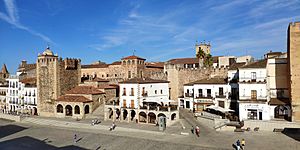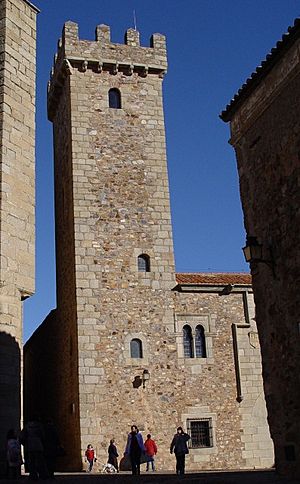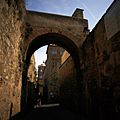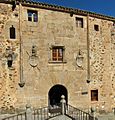Old Town of Cáceres facts for kids
Quick facts for kids
Old Town of Cáceres
Ciudad Monumental de Cáceres
|
|||||||||||||||||||||||||||
|---|---|---|---|---|---|---|---|---|---|---|---|---|---|---|---|---|---|---|---|---|---|---|---|---|---|---|---|
|
Neighbourhood
|
|||||||||||||||||||||||||||
 |
|||||||||||||||||||||||||||
| Country | |||||||||||||||||||||||||||
| Autonomous community | |||||||||||||||||||||||||||
| Province | Cáceres | ||||||||||||||||||||||||||
| Municipality | Cáceres | ||||||||||||||||||||||||||
|
|||||||||||||||||||||||||||
The Old Town of Cáceres is a historic walled city in Cáceres, Spain. It is a very old place with a rich history.
UNESCO named Cáceres a World Heritage City in 1986. This was because of its unique mix of building styles. You can see Roman, Moorish, Northern Gothic, and Italian Renaissance architecture designs. About thirty towers from the Islamic period still stand. The Torre del Bujaco is the most famous of these.
People have lived near Cáceres since ancient times. Proof of this can be found in the caves of Maltravieso and El Conejar. The Romans founded the city in 25 BC.
The Old Town, also called Parte Antigua, still has its original ancient walls. This area is also famous for its many storks' nests. Inside the walls, the town looks like it did in the Middle Ages. There are no modern signs, which is why many TV shows and movies have been filmed here.
Contents
Discovering the History of Cáceres
The story of Cáceres began in prehistoric times. Paintings in the Cuevas de Maltravieso (Maltravieso Caves) show this. These paintings are from the late Paleolithic period. Visitors today can see remains from the Middle Ages, the time of Roman occupation, Moorish rule, and the Golden age of Jewish culture in Spain. Cáceres has four main parts to explore: the historical quarter, the Jewish quarter, the modern center, and the areas just outside the city.
Exploring the Old Town's Sections
The Old Town of Cáceres is divided into two main areas by its wall. These are "intramuros" (inside the wall) and "extramuros" (outside the wall). The area inside the walls is known as the "Monumental City" or "Old Part." It is the most famous part. The area outside the walls is less known but also important.
Since the Middle Ages, the Old Town has been split into four parishes. These are Santa Maria, San Mateo, Santiago, and San Juan. The first two are inside the walls, and the last two are outside.
Inside the Walls: Santa María Quarter
The Santa Maria quarter combines two squares: Plaza de Santa María and Plaza de los Golfines. This creates one large, special area. The Holy Church Cathedral of Santa María la Mayor stands in the center. Many palaces, mansions, and noble houses surround it.
Next to the Cathedral is the Palacio de Carvajal. This building now houses the Tourist Board. You can visit its inside, including the patio and garden. At the end of Calle Tiendas, you can see the Torre de The Espaderos. Back in Plaza de Santa María, you will find the Palacio de Hernando de Ovando and the Episcopal Palace.
Further on, in Plaza del Conde de Canilleros, is the Toledo-Moctezuma Palace. This is now home to the Provincial Historical Archives. Other important buildings here include the Mayoralgo Palace and the House of Moraga. The House of Moraga is now a Provincial Center of Crafts. You can also see the House of Golfin-Toledo and the magnificent Palace of Golfines de Abajo. This palace once hosted Queen Isabella I of Castile and King Fernando I.
Inside the Walls: Saint George Square
The Plaza de San Jorge is in the middle of the walled city. Three main buildings stand out here. The Church of San Francisco Javier, also called the Church of the Precious Blood, is a key feature. Its crypt has an Interpretation Center for Holy Week in Cáceres. You can also access the city's largest cistern from here.
Next to the church is the College of the Company of Jesus. This beautiful Baroque group of buildings dominates the square. To the right, you will find the House of the Becerra. This building is now the headquarters of the Mercedes Calles and Carlos Ballestero Foundation. To the left, behind some souvenir shops, is the Garden of Cristina de Ulloa. This open space is dedicated to the city's patron saint.
Inside the Walls: San Mateo Quarter
The San Mateo quarter is smaller than Santa Maria. It has three squares: Plaza de San Mateo, Plaza de San Pablo, and Plaza de las Veletas. The Church of San Mateo, built on an old mosque, is the main building here. There is also the Convent of San Pablo, another religious building.
Among the civil buildings, the Palace of the Cáceres Ovando, or Palace of the Storks, is very important. It is now the Military Government headquarters. In Plaza de las Veletas, you will find the Palace of Veletas. This palace houses the Archeology and Ethnography Section of the Museum of Cáceres. It also has a wonderful Almohad cistern, the oldest in the city. The House of the Horses, which holds the Fine Arts Section of the Museum of Cáceres, is also nearby.
Behind the Church of San Mateo, there is a small square with three lovely buildings. These are the House of the Sun, the House of the Eagle, and the Tower of Sande. If you return to Plaza de San Mateo, you can see the impressive Palace of Golfines de Arriba.
From San Mateo, you can walk down Calle Ancha. Here you will admire many old buildings. These include the House of Lorenzo Ulloa, now the School of Fine Arts. Other notable buildings are the House of Diego de Ulloa the Rico and the Palace of the Commander of Alcuéscar. The latter is now a Parador hotel.
After crossing Calle Ancha, you will reach the Puerta de Mérida. To the right, you can see the Hospital de los Caballeros. To the left, you will find the House of the Perers, which is now a college.
Inside the Walls: The Adarve of the Star
From Plaza de San Mateo, if you take Calle Condes, you will reach the Adarves area. Adarves are streets next to the wall, also known as the round road. In Cáceres, five streets keep the name Adarves. However, when people say "the adarves," they usually mean the first three. These are Father Rosalío, Santa Ana, and Estrella. They form a sloping street with narrow parts and small stone pavement.
In this area, you can see the Arco de Santa Ana and Puerta del Postigo. There are also the Tower of the Ved and the Tower of Santa Ana. In a small square in front of the Arch of Santa Ana is the Palace of the Counts of Adanero. As you go down the adarves, you will find the entrance to Casa Miron on the left. This is the Municipal Museum of Cáceres. A little lower on the right is the Plaza de los Caldereros.
This square is bordered by two buildings facing each other: the Palacio de la Generala and the Palace of Ribera. Both buildings are now part of the University of Extremadura. In front of Plaza de los Caldereros, a small door leads to stairs down to the Forum of the Balbos. From here, you can see the Town Hall and the Plaza Mayor.
If you go all the way down the adarves and return to Plaza de Santa María, near the House of Moraga, you can explore charming streets and alleys. Here, an axis formed by Cuesta de Aldana and Olmos streets begins. These are narrow and winding. Important buildings here include the Mono House, the Casa del Aldana, the Mudéjar House, and the San Antonio Nursery. The small square where the San Antonio Nursery is located ends where Calle Puerta de Mérida meets Adarve of Father Rosalío. Here, you can see the Hospital of the Magdalena.
Inside the Walls: Old Jewish Quarter
The Arco del Cristo is the eastern gate of Cáceres's old wall. It has Roman stones and was once the gate of the ancient colony Norba Caesarina.
Cáceres once had two Jewish neighborhoods. The Old Jewish Quarter was inside the walls. The other Jewish Quarter was outside the walls. The Old Jewish Quarter is also known as the neighborhood of San Antonio de la Quebrada. It still has the typical narrow, sloping streets of Islamic and Jewish times. These streets have small squares connected to each other. Some streets are "dead ends," meaning they have no exit.
The houses are small, with one or two floors. Most are white and decorated with flowers like geraniums. This gives the neighborhood a special charm. It includes streets like San Antonio, Callejón del Moral, Rincon de la Monja, and Cuesta del Marqués. The main building and center of the old Jewish quarter is the Ermita de San Antonio. It was built on the old synagogue.
An interesting house is the House of the Rich Jew. It has a stone facade instead of being covered with lime, which was typical for humble Jewish houses. In the same Jewish quarter, you can access the Baluarte de los Pozos through one of its houses. This is a part of the wall with two towers: the Tower of the Wells and the Tower Coraja. It was important for getting water from the Ribera. Also, near the Pizarro Gate, you will find the Olivar de la Juderia. This is a garden or park space at the foot of the wall.
If you continue on Rincón de la Monja street, where it meets Cuesta del Marqués, you will see two important buildings. One is the House of Durán de la Rocha, and the other is the Arab Museum House. When you go down Cuesta del Marqués, you reach the lowest and easternmost point of the Monumental City. Here you will find the Arco del Cristo. This is the only Roman gate that still exists in the city. From this spot, you can see the Round Tower and, after crossing the arch, the River Tower.
Outside the Walls: Main Square and Surroundings
When the area inside the walls became too full, people started building outside. This new growth happened around three main places: the Plaza Mayor and the two parishes of Santiago and San Juan.
The Lively Main Square
The Plaza Mayor is the heart of the Historic Quarter. It is also the main entrance to the Monumental City. It started as a large market space outside the walls. On its east side, you can see the Tower of Bujaco, the Hermitage of the Peace, and the Arc of the Star. You can also spot the Tower of the Pulpits and the Tower of the Yerba. To the south is the Town Hall, built in the late 1800s. The rest of the Plaza Mayor has arcades that began in the 1500s. The buildings above them are from different time periods.
These arcades once housed various guilds. There was the Bread Portal, the Silversmiths' Portal, and the Scribes' Portal, among others. Other guilds settled in streets near the Plaza Mayor. These include the well-known Calle Pintores and streets like Paneras, Hornos, and Zapatería. Around the Plaza Mayor are the two medieval parishes, Santiago and San Juan. New spaces were created around them, forming the urban structure outside the walls.
Key Places to See
Cathedrals and Churches
- Church and convent of San Pablo (15th century)
- Convent of la Compañía de Jesus, a Baroque-style building now used for art shows
- Church of Santa María, a cathedral built in the 13th century in Gothic style
- Iglesia de San Mateo, a 15th-century church built where an old mosque used to be
- Iglesia de San Francisco Javier (18th century), in Baroque style
- Iglesia de San Juan, a large and grand church built between the 13th and 15th centuries
- Hermitage of San Antonio
- Iglesia de Santo Domingo
- Hermitage de la Paz
- Church of Santiago
The Historic Wall
- Torre de Bujaco (12th century)
- Arco de la Estrella (18th century)
- Torre de Sande (14th–15th centuries)
Palaces and Grand Homes
- Palacio de los Golfines de Abajo. Queen Isabella I of Castile and King Fernando I once stayed here.
- Palacio del Comendador de Alcuescar
- Palacio de los Golfines de Arriba
- Palacio-Fortaleza de los Torreorgaz, now a Parador hotel
- Palacio de Carvajal (15th century)
- Palacio casa de los Becerra
Gallery
See also
 In Spanish: Ciudad Monumental de Cáceres para niños
In Spanish: Ciudad Monumental de Cáceres para niños













